Participatory planning with relative vulnerability and needs assessment in the project villages
BY SHABERI DAS, SUGATA HAZRA AND SUDIPA PAL • JULY 12, 2023
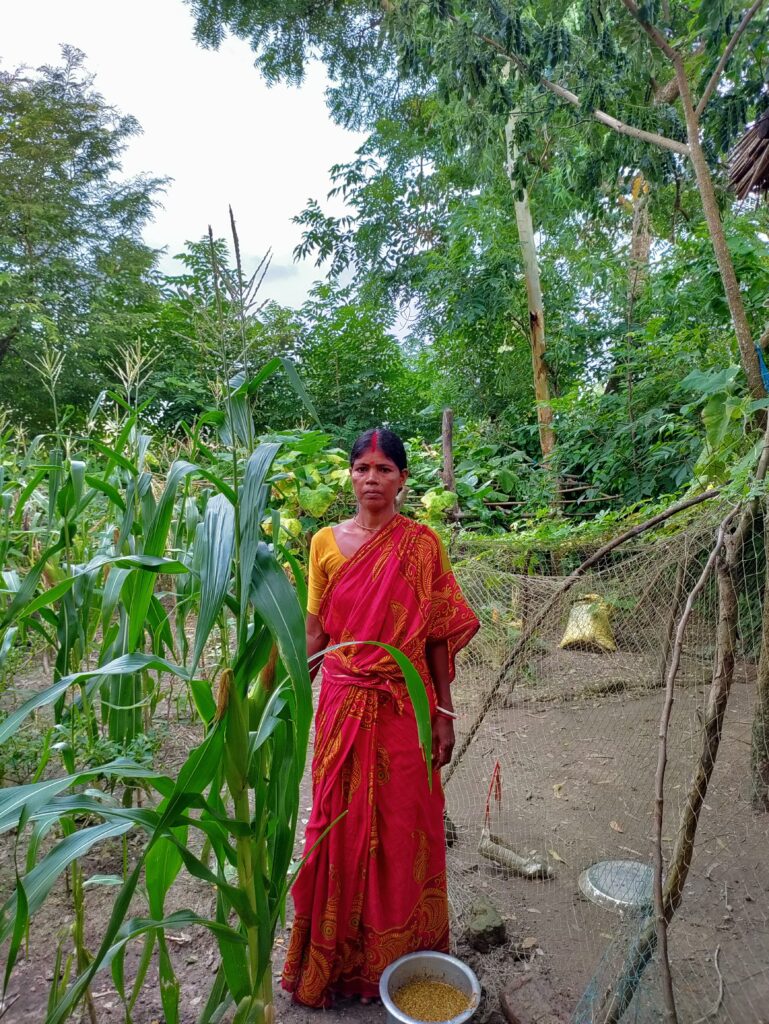
Figure: A woman stands in front of her nutrition garden in Shyamnagar village, Kultali CDB
Participatory vulnerability and capacity assessment (PVCA), as discussed in a previous article, is a systematic way of understanding and assessing the vulnerabilities experienced by communities in contexts where disasters and climate change are significant drivers of poverty and suffering, while needs assessment is a systematic questionnaire-led survey used to understand the needs of the communities. Using participatory rural appraisal (PRA) tools, the Sound of Silence (SoS) project team conducted PVCA exercises and needs assessment survey (NAS) for 800 households in all 8 project villages across the 4 community development blocks (CDBs) comprising the project area, ensuring that each household is represented by at least one woman member. PVCA and NAS data was collected from Lebukhali and Kothabari villages in Hingalganj CDB, Kukrekhali and Dargapara villages in Sandeshkhali I CDB, Uttar Kasiabad and Kasiabad villages in Kakdwip CDB, and Shyamnagar and Kantamari villages in Kultali CDB.
The findings from these two studies helped Team SoS to conduct participatory planning to enhance the adaptive capacity and climate resilience of Adivasi communities in the project villages. The present article summarizes these findings, and discusses insights gained and the way ahead.
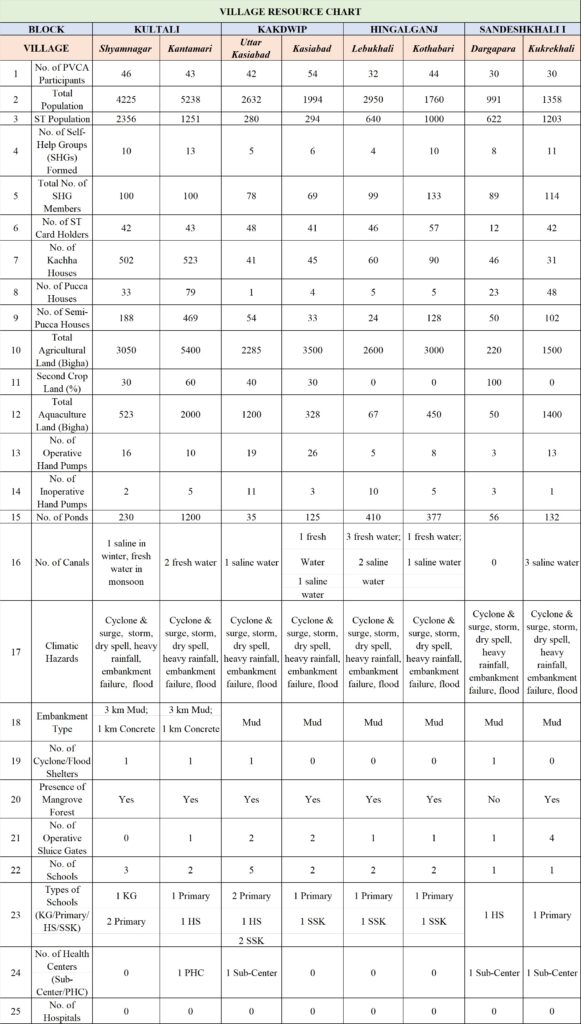
Figure: Resources available to the communities in the project villages
The communities in each of the project villages live within close proximity to a river, in low-lying settlements protected predominantly by mud embankments and some mangrove cover including species such as bain (Avicennia officinalis), keora (Sonneratia apetala), geowa (Excoecaria agallocha), goran (Ceriops decandra), and hetal (Phoenix paludosa) along the riverbank. Thus, the areas suffer from high biophysical vulnerability to a number of environmental and climatic hazards including cyclone and surge, storm, heavy rainfall, embankment failure, flood, and dry spell due to delayed monsoon, which have increased in frequency and intensity in the last two decades.
With the insights from PVCA, we analysed the relative vulnerability of the tribal communities in order to better understanding how we may tailor our approach to enhancing adaptive capacity in each village in view of their respective sensitivity and vulnerability to environmental and climate change. In our computation of relative vulnerability, the following components and parameters have been given due consideration, in view of the conceptual framework of the Fourth Annual Report (AR4) of the Intergovernmental Panel on Climate Change (IPCC).
Exposure
The IPCC defines exposure as “the nature and degree to which a system is exposed to significant climatic variations.” According IPCC AR4, exposure is considered as a function of climate variability various climatic extremes (delayed monsoon cyclone and surge, storm, heavy rainfall, saline flood due to bank erosion) occurring in the area.
Sensitivity
The IPCC defines sensitivity as “the degree to which a system is affected, either adversely or beneficially, by climate-related stimuli.” Our analysis included data for the following parameters of sensitivity, and yielded the following insights.
1. Agricultural landholding and agricultural labour: Higher agricultural landholding and higher dependence on agricultural labour contribute to higher sensitivity to the impacts of environmental and climate change.
2. Ecosystem dependence (artisanal fishing and crab collection): Higher ecosystem dependence increases a community’s sensitivity.
3. Scarcity months: Scarcity of food, fuelwood, drinking water, work availability, and fodder contributes to a community’s sensitivity.
4. Debt: Being in debt, especially during the lean season when freshwater unavailability and scarcity necessitate borrowing from moneylenders or banks, heightens a community’s sensitivity.
5. Proportion of female population and dependent population (children <6 years): While disaggregated data on gender and proportion of dependents (obtained from Census 2011) did not show much variability, it was included in our analysis in acknowledgement of the fact that certain sections of society, like women and children, are disproportionately affected by climate change.
6. Proportion of non-workers: A higher proportion of non-workers within the village (obtained from Census 2011 data) contributes to higher sensitivity of the communities to environmental and climate change.
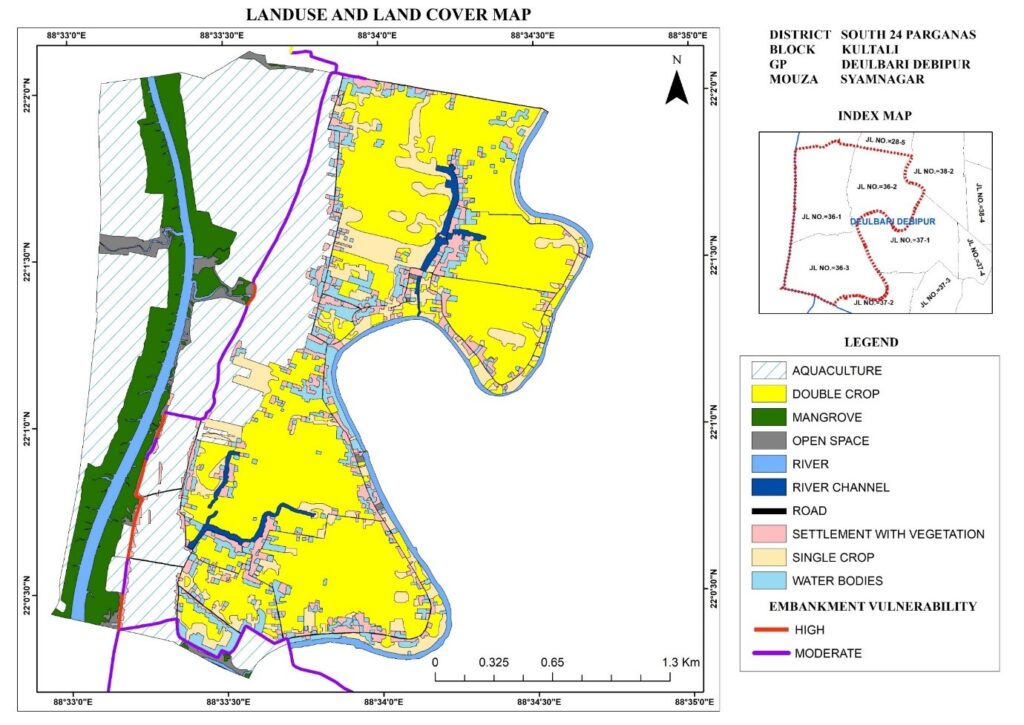
Figure: High resolution mapping of Shyamnagar village (Kultali CDB) using GIS and remote-sensing technology
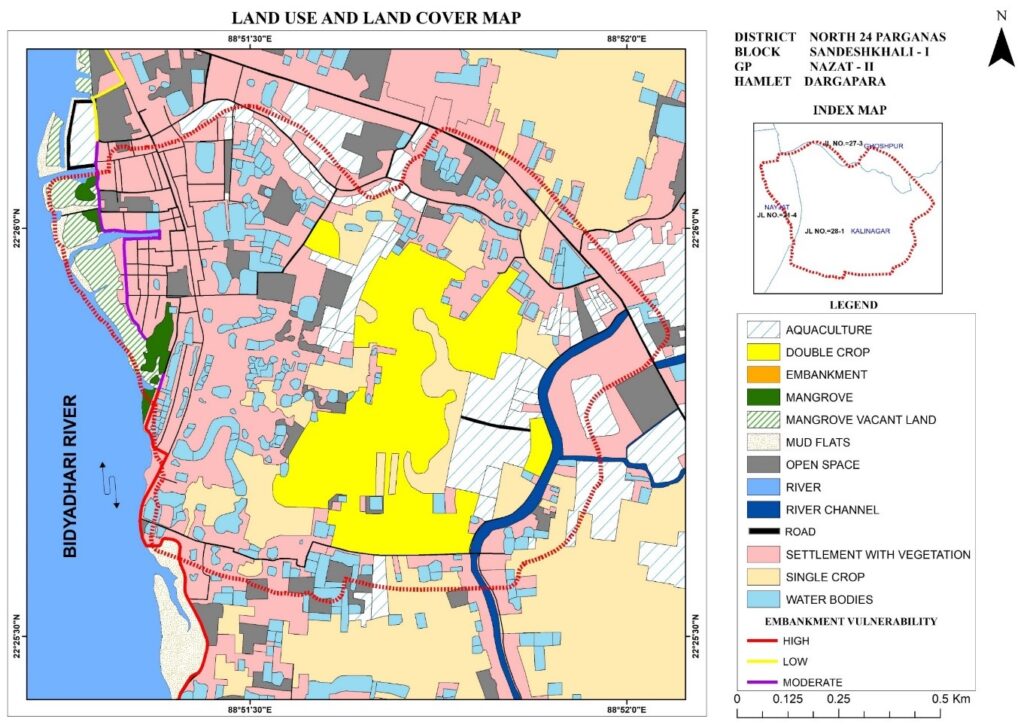
Figure: High resolution mapping of Dargapara village (Sandeshkhali I CDB) using GIS and remote-sensing technology
Adaptive Capacity
According to the IPCC, adaptive capacity is “the ability of a system to evolve in order to accommodate climate changes or to expand the range of variability with which it can cope.” In our analysis, the following parameters of adaptive capacity have been considered in our analysis and have yielded the below-mentioned insights.
1. Proportion of Permanent/pucca houses (concrete walls, floor and roof): Since permanent/pucca and semi-permanent/semi-pucca houses are more cyclone- and flood-resistant than temporary/kachcha houses (mud walls and floor and thatched/earthen-tiled roof), a higher proportion of pucca and semi-pucca houses within the community indicates higher adaptive capacity of the community.
2. Embankments (earthen and concrete): The presence of embankments along the riverbank indicates higher adaptive capacity of the community. Communities protected by concrete embankments consider themselves safer and more resilient to environmental and climate changes.
3. Percentage of second-crop cultivation: Communities with a higher percentage of second-crop or better cropping intensity through rainwater harvesting and minor irrigation cultivation demonstrate a higher adaptive capacity compared to communities with a higher percentage of single-crop cultivation.
4. Dependence on daily wage labour: Communities that are more dependent on daily wage labour demonstrate a higher adaptive capacity.
5. Dependence on animal husbandry: The higher the proportion of households that practice animal husbandry within a community, the higher is the community’s adaptive capacity.
6. Dependence on temporary migration: Communities that demonstrate high dependence on income from temporary migration as a coping strategy have higher adaptive capacity.
7. Proportion of operative hand pumps: Communities with a high proportion of operative hand pumps (for perennial freshwater supply) in their village have higher adaptive capacity.
8. Presence of Health Centre: Communities with at least one healthcare centre in the village have a higher adaptive capacity.
9. Proximity to hospital: Health services availability has been computed in terms of distance from the community and the time taken to reach the hospital from the village, varying from 15 to 150 mins. The lesser the distance/time taken to travel from the village to the nearest hospital, the greater is the adaptive capacity of the community.
10. Proximity to primary school: The accessibility of primary education has been computed in terms of distance from the community and the time taken to reach the nearest primary school from the village, varying from 5-60 mins. The lesser the distance/time taken to travel from the village to the nearest primary, the greater is the adaptive capacity of the community.
Vulnerability
The IPCC has defined vulnerability as “the degree to which geophysical, biological and socio-economic systems are susceptible to, and unable to cope with, adverse impacts of climate change, including climate variability and extremes.” In our analysis, vulnerability has been considered as a function of exposure, sensitivity, and adaptive capacity.
With primary data from the PVCA exercises and secondary data from the last Indian Census Survey (2011), the relative vulnerability of each village within the project area was analysed.
The relative vulnerability analysis has generated the following observations, keeping in view that the villages show more or less similar ‘’exposure to climatic variability and hazards, which indicates that vulnerability is directly proportional to the ratio of sensitivity to adaptive capacity; or V ∝ S/A.
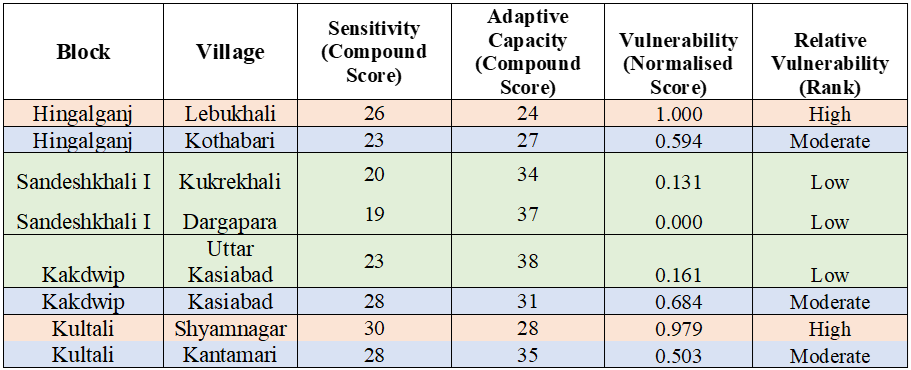
Figure: Relative vulnerability of the project villages
High Relative Vulnerability
Lebukhali village in Hingalganj CDB and Shyamnagar village in Kultali CDB appear to be highly vulnerable to the environmental and climate change impacts.
In Lebukhali, a high proportion of non-permanent (kachcha) houses with improper sanitation, high proportion of mono-crop cultivation, and high dependence on ecosystem services (artisanal fishery and crab collection), low-to-moderate dependence on remittance income from temporary migration as an adaptive response, fewer operative hand pumps, and limited access to facilities like healthcare (primary healthcare centre and hospital) and primary education, contribute to higher relative vulnerability.
In Shyamnagar, a high proportion of non-permanent (kachcha) houses with improper sanitation, high proportion of agricultural landholding and dependence on agricultural labour and ecosystem services, and limited access to healthcare facilities, contribute to higher relative vulnerability.
Moderate Relative Vulnerability
Kothabari village in Hingalganj CDB, Kasiabad village in Kakdwip CDB, and Kantamari village in Kultali CDB appear to have moderate relative vulnerability to environmental and climate change impacts. In these villages, a high proportion of permanent (pucca and semi-pucca) houses with proper sanitation, high proportion of agricultural landholding and dependence on agricultural labour, closer proximity of a storm/flood shelter, moderate-high dependence on remittance income from temporary migration as a coping mechanism, and varying access (poor-moderate) to facilities like healthcare (primary healthcare centre and hospital) and primary education, contribute to moderate relative vulnerability.
Low Relative Vulnerability
Kukrekhali and Dargapara villages in Sandeshkhali I CDB, and Uttar Kasiabad village in Kakdwip CDB appear to be relatively less vulnerable to the environmental and climate change impacts. A high proportion of permanent (pucca and semi-pucca) houses with proper sanitation, low dependence on ecosystem services, closer proximity of a storm/flood shelter, moderate dependence on remittance income from temporary migration as a coping mechanism, better access to healthcare and primary education, contribute to lower relative vulnerability.
Findings from PVCA
The relative vulnerability analysis from PVCA indicates that the major causes for vulnerability or lack of adaptive capacity are controlled by:
1. Lack of proper/permanent housing and sanitation;
2. Higher dependence on ecosystem services (artisanal fishery and crab collection);
3. Higher proportion of dominantly monocrop agriculture due to lack of freshwater;
4. Limited access to healthcare and educational facilities; and
5. Limited access to the legitimate rights and privileges of the communities.
Additionally, the project team has noted the significant increase in the number of aquaculture farms in the villages, which has serious implications for their vulnerability.
Findings from NAS
Findings from NAS indicate that the following needs of Adivasi communities must be met to enhance their adaptive capacity.
1. Acquisition of caste certificates to access benefits entitled to Adivasis;
2. Generation and strengthening of alternative non-farm livelihoods;
3. Intensification of freshwater availability and agriculture;
4. Improvement of access to safe drinking water, good sanitation and hygiene (WaSH);
5. Improvement of access to adequate healthcare, education and government facilities;
6. Enhancement of the protection and maintenance of embankments and mangroves; and
7. Discouraging abuse of alcohol and other substances.
Participatory Planning using the findings from NAS and PVCA
The SoS project aims to improve upon the communities’ adaptive capacities through their participation in the following measures for climate risk reduction.
1. Obtain Scheduled Tribe (ST) certification for access to special government facilities to decrease their climate risk and amplify their voices;
2. Disseminate weather forecast and early warning through information hubs;
3. Increase cropping intensity and natural farming using indigenous and climate-resilient varieties of crops, and promoting nutrition gardening;
4. Diversify livelihoods and alternative income sources by promoting animal husbandry, fisheries, and non-farm livelihoods;
5. Mobilise women’s self-help groups to plant mangroves and protect embankments;
6. Organise health camps and strengthening health and mental health support; and
7. Promote mutual cooperation groups and facilitating formation of youths-in-action groups to strengthen the abilities of the future generation to adapt to climate change.





Team SOS looks forward to sharing more such insights on community-level implementation of these measures soon. In the meantime, please share your thoughts and insights on this with us in the comment section below or write to us at soundofsilenceresearch@gmail.com because every voice matters and none must be silenced!

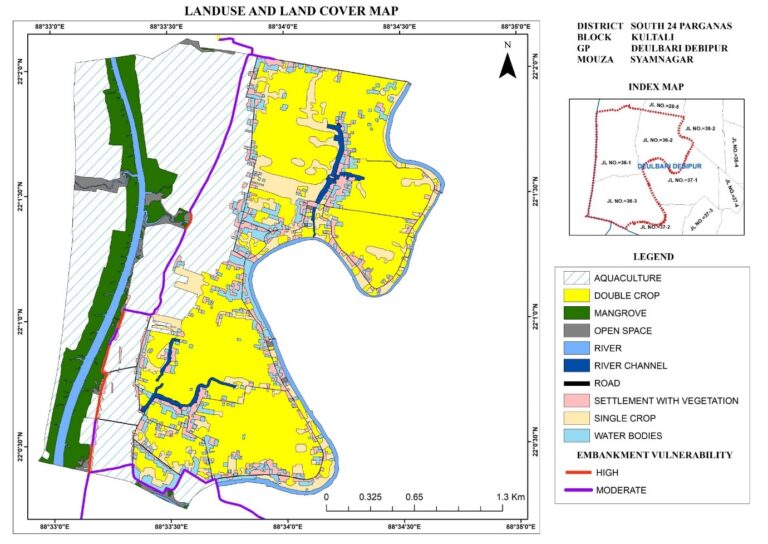
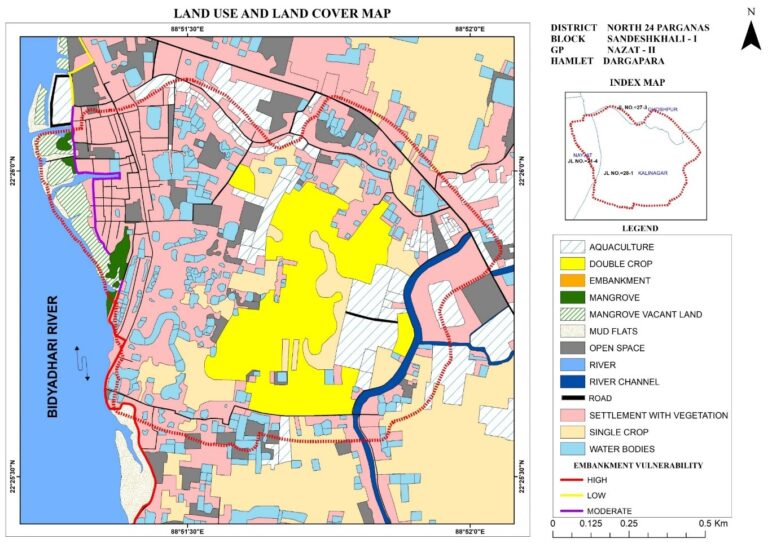

6 thoughts on “Participatory planning with relative vulnerability and needs assessment in the project villages”
Great. Good analysis
Excellent report and Village Resource Chart is outstanding.
Excellent analysis. But we also need to broaden the behavioural study to the interior of Bengal, where there are periodic droughts and floods, and how people rebuild themselves after such natural disasters.
Good analysis , nothing much is mentioned however about Roof based rain-water harvest; and about the resilience of the vegetables and animals chosen ,and also the changes in their growth rate /food habit etc, will read later on a bigger screen ,this is my initial reaction
The analytical portion is excellent. Want to know more about the measures taken regarding enhancing adaptive capacity?
Elephant Foot Yam and Beetle Vine cultivation under shed net along with linkage with SDB ( Sundarban Development Board )and Backward Class Development Department may be helpful for the tribal women’s of the project areas.